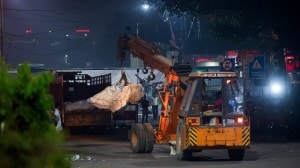India Shelter Finance: Cracking the code on small-town lending
While most lenders focus on salaried customers in metros, India Shelter has quietly built a high-margin lending machine in small-town India, where few dare to go. Its loan book has grown over 40% year-on-year, return on equity (ROE) stands at 14%, and bad loans are just 1.3%. The market is starting to take note — but the real test still lies ahead.
 India Shelter's loan book has seen a quiet transformation over the last few quarters. (India Shelter Finance Facebook)
India Shelter's loan book has seen a quiet transformation over the last few quarters. (India Shelter Finance Facebook)Lending to self-employed borrowers in small-town India has long been viewed as a risky business. Incomes are volatile, documentation is patchy, and collections can be difficult. Yet, India Shelter Finance is proving that it’s not only possible — it can be profitable.
Its loan book has grown over 40% year-on-year, return on equity (ROE) stands at a respectable 14%, and bad loans are just 1.3%. While most lenders focus on salaried customers in metros, India Shelter has quietly built a high-margin lending machine where few dare to go.
Investors are starting to take notice. The stock is up over 40% from its January lows, and the recent price action suggests growing confidence in its long-term potential.
 Source: http://www.tradingview.com
Source: http://www.tradingview.com
Cracking the code on Bharat lending
Affordable housing finance is a crowded market. But lending profitably to self-employed borrowers in Tier 2 and Tier 3 towns? That remains a playbook only a few have mastered. Names like Aavas Financiers and Aptus Value Housing stand out for their strong asset quality and stable RoEs.
Now, a new contender is emerging — India Shelter.
Over 70% of its borrowers are self-employed, 90% live in Tier 2 and Tier 3 cities, and the average loan size is just Rs 10 lakh. These aren’t borrowers with good credit scores and clean documentation. But India Shelter has made it work by blending tech-led onboarding with on-ground sourcing, keeping LTVs below 55%, and growing its loan book by over 40% in the past year — all while maintaining profitability and controlling bad loans.
 Source: India Shelter Finance Q3FY25 Investor Presentation.
Source: India Shelter Finance Q3FY25 Investor Presentation.
But is the growth sustainable? Let’s find out.
A shifting product mix — with a hidden twist
India Shelter’s loan book has seen a quiet transformation over the last few quarters. While its average ticket size has stayed around Rs 10 lakh, the company has indicated that it wishes to increase the percentage of home loans vs LAP (Loan Against Property). Home loans account for 58% of the reported portfolio — up only marginally from a year ago — while LAP makes up the remaining 42%. At first glance, this may not seem like a big shift. But dig deeper, and there’s more going on.
 Source: Investor Presentation / India Shelter Finance & Aavas Financiers.
Source: Investor Presentation / India Shelter Finance & Aavas Financiers.
A significant portion of the LAP loans is regularly sold to banks through direct assignment (DA) — a funding arrangement that frees up capital and reduces credit risk. Since most of what’s sold is LAP, the on-balance-sheet exposure to home loans adjusted for LAP-DA transactions is over 70%, according to management. So while the headline numbers appear stable, the economic mix has already shifted toward home loans — a lower-risk, more predictable product.
While product mix is a key indicator of underlying risk, the types of customer service categories can also help investors gauge the underlying risk. Most affordable housing finance companies break down customers into two categories: salaried versus self-employed. The conventional belief is that self-employed customers are riskier of the two. As a consequence, most analysts and investors expect that a lender will maintain a lower percentage of self-employed in the loan mix. India Shelter, however, is increasing its exposure to self-employed customers, consciously.
 Source: Source: India Shelter Finance Q3FY25 Investor Presentation.
Source: Source: India Shelter Finance Q3FY25 Investor Presentation.
While this appears riskier, the company manages the risk of default by keeping a loan-to-value (LTV) of 52%, leaving a significant margin of safety in case of default.
But the true measure of its underwriting strength will come as its loan book matures.
According to Divyansh Gupta, co-founder at Latent Advisors PMS, “Lagged NPAs can be a better measure of underlying asset quality because it adjusts for AUM growth. For example, while the headline GNPA for FY24 is 1% for India Shelter Finance, the 1-year lagged NPA is estimated at 1.6%. This means that on the AUM India Shelter had one year ago they have an estimated GNPA of 1.6%. Essentially lagged NPA removes the effect of the loans disbursed in the last 1 year.”
In contrast, Aavas Financiers’ lagged NPA is estimated at 1.15%, highlighting its more seasoned portfolio and possibly explaining its higher 4.4x P/B valuation versus India Shelter’s 3.4x.
For India Shelter Finance, at least 50% of the loans have less than 3 years of vintage — the true asset quality is likely to emerge over time.
How India Shelter is protecting its spread
India Shelter’s interest spreads — the difference between yield on loans and cost of borrowings have barely changed — have held steady at around 6% for six consecutive quarters. This is always welcome as every lender tries to maintain spreads, and its ability to do so reflects the stability of operations and profitability.
 Source: India Shelter Finance Investor Presentation.
Source: India Shelter Finance Investor Presentation.
While most of its loans remain fixed-rate (~60%), its borrowings are mostly floating — a mismatch that could hurt margins if interest rates fall.
At first glance, falling interest rates should help — if the cost of funds drops and loan yields stay fixed, margins should improve. But India Shelter’s position is trickier. It risks being stuck with older, high-rate loans in a market where competitors can start offering cheaper credit. That could lower its competitiveness and increase balance transfers – the percentage of AUM that is transferred to another lender, usually banks or NBFCs which are offering lower rates.
To counter this, the company is shifting 85% of new disbursements to floating-rate loans while continuing to sell fixed-rate LAP loans through DA. It’s a smart way to lock in high returns today while preparing for rate cuts tomorrow.
 Source: India Shelter Fianance Q3FY25 Investor Presentation.
Source: India Shelter Fianance Q3FY25 Investor Presentation.
By comparison, Aavas Financiers — with 69% of loans and 69% of borrowings at a floating rate — has seen spreads decline from 5.75% to 4.94% over the last two years as borrowing costs climbed, but Aavas was unable to pass on the increases on the yields to customers. Perhaps this is also why it has a better asset quality compared to India Shelter.
India Shelter is getting ahead of the curve — moving proactively rather than reactively.
Asset quality: Steady but not stress-free
India Shelter’s gross NPAs has increased from 1.0% to 1.3% over the last four quarters, even as credit costs have stayed in a stable band of 45–47 basis points.
The company attributes the uptick to a combination of localised collection challenges and a broader softening in borrower cash flows — especially in the informal, self-employed segment that makes up over 70% of its customer base.
One notable case came from Madhya Pradesh, where senior field staff attrition hurt collections — but the company has since restructured operations and improved recovery efficiency.
In comparison, Aavas Financiers reported a GNPA of 1.14% and NNPA of 0.81% as of December 2024, almost identical headline figures. But the breakdown tells a deeper story: its home loan GNPA is only 1.07%, while non-home loans are at 1.45% — showing that asset quality deterioration is concentrated in higher-risk segments. One reason why Aavas has a relative edge is its more salaried or semi-formal borrower base and a slower growth rate.
India Shelter, by contrast, is growing faster and lending deeper into the informal ecosystem. Its slightly higher GNPAs reflect that positioning — but so far, credit costs remain under control, and collection efficiency trends are stabilising, pointing to a business that is managing risk, not ignoring it.
Profitability: ROEs catching up — and maybe surpassing
India Shelter has steadily expanded its ROE over the last five years — from just 5.7% in FY20 to 14.7% in 9MFY25. This improvement has been driven by a combination of factors: rising operating leverage, stable spreads, and disciplined credit cost management despite lending to a riskier borrower base. The cost-to-income ratio has steadily improved from over 45% to just above 41% in FY24, and RoA has ticked up to 5.5% — among the highest in the industry.
For context, Aavas Financiers — long considered a benchmark in affordable housing — reported an ROE of 14.06% in 9MFY25, only marginally lower than India Shelter’s but improving.
The gap has narrowed significantly. If spreads hold and operating efficiency improves, India Shelter could start outperforming legacy peers not just in growth, but in profitability as well.
Fairly valued but under a watch
India Shelter currently trades at a Price-to-Book (P/B) multiple of around 3.5x, slightly above its short-term median of 3.3x. But with the stock listed only in December 2023, historical comparisons are limited. Still, the market has started to reward its execution — the stock has rerated from a low of 2.7x to the current range.
 Source: http://www.tijorifinance.com
Source: http://www.tijorifinance.com
One undeniable risk, though, is vintage. A large part of India Shelter’s current book has been built in the last three years — a period of aggressive growth. While early performance has been solid, the real test of credit quality revelas itself over time. — and legacy players like Aavas have an edge here.
For that reason, perhaps, Aavas Financiers trades at ~4.4x P/B, which is below its historical median of 5.3x, built over a decade of performance.
So while India Shelter looks fairly valued on headline numbers, its upside will likely depend on one thing: how well the current book ages and whether it can balance growth, asset quality and profitability.
Still, when you combine improving ROEs, contained credit costs, and a focus on risk-adjusted growth, the valuation argument doesn’t look stretched — especially if India Shelter continues to prove that its growth isn’t coming at the cost of asset quality.
Note: We have relied on data from http://www.Screener.in and http://www.tijorifinance.com throughout this article. Only in cases where the data was not available have we used an alternate, but widely used and accepted source of information.
Rahul Rao has helped conduct financial literacy programmes for over 1,50,000 investors. He also worked at an AIF, focusing on small and mid-cap opportunities.
Disclosure: The writer or his dependents do not hold shares in the securities/stocks/bonds discussed in the article.
The website managers, its employee(s), and contributors/writers/authors of articles have or may have an outstanding buy or sell position or holding in the securities, options on securities or other related investments of issuers and/or companies discussed therein. The content of the articles and the interpretation of data are solely the personal views of the contributors/ writers/authors. Investors must make their own investment decisions based on their specific objectives, resources and only after consulting such independent advisors as may be necessary.


- 01
- 02
- 03
- 04
- 05





























